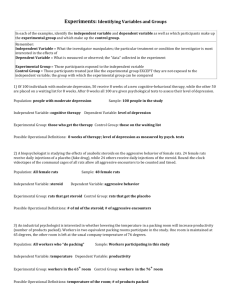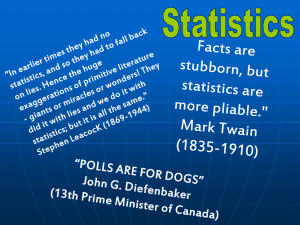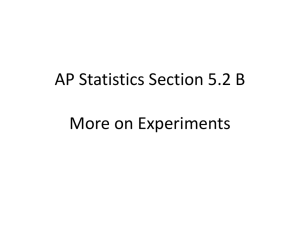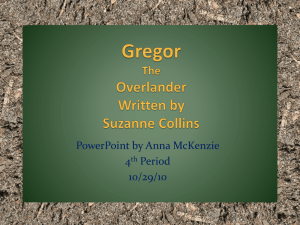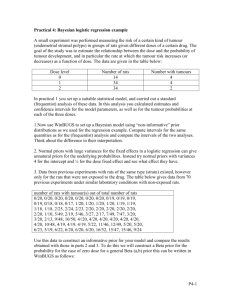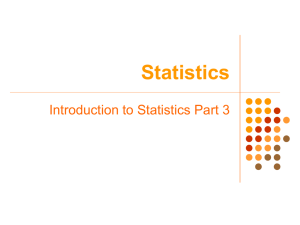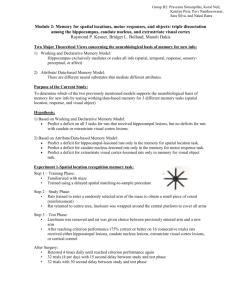Ch. 4 Practice Test reformatted
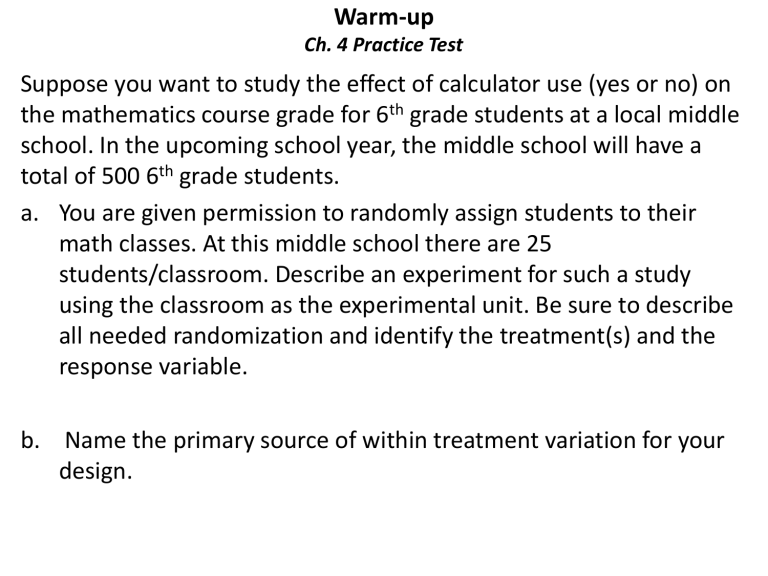
Warm-up
Ch. 4 Practice Test
Suppose you want to study the effect of calculator use (yes or no) on the mathematics course grade for 6 th grade students at a local middle school. In the upcoming school year, the middle school will have a total of 500 6 th grade students.
a. You are given permission to randomly assign students to their math classes. At this middle school there are 25 students/classroom. Describe an experiment for such a study using the classroom as the experimental unit. Be sure to describe all needed randomization and identify the treatment(s) and the response variable.
b. Name the primary source of within treatment variation for your design.
4.4 E 38 and 40
38. The 23 experimental units are assigned randomly to the four groups.
The treatment for one group is a special exercise program. The treatment for another group is a standard exercise program. The other two groups were not given any special exercise or instructions but one group had to check in every week. The other group had to check in only at the end of the experiment. The response being measured was when the infants were able to walk on their own.
40. Rats were randomly assigned to the three groups. The three groups were new treatment, old treatment, and no treatment. Assuming the rats did not have stomach lesions before the treatment, random assignment seems appropriate. If rats do have stomach lesions, blocking would be necessary (no, some, and many stomach lesions)
The experimental units were the rats. The response variable is the length of stomach lesions.
There is no placebo. Rats may not be aware of the treatment if it is being mixed in their water or food, so a placebo is not necessary. If rats are being handled for the medication, a placebo could be necessary because the stress of being handled may add to their stomach lesions
Student of the day!
Block 4
Student of the day!
Block 5
Student of the day!
Block 6
Directions for Practice Test
• Complete the practice test quietly by yourself for the first 30 minutes.
• After the 30 minutes, you may discuss the answers at your tables.
• The answers will be displayed and then you may ask questions.
• Have your vocabulary numbered #1-37 and notes with warm-ups ready for the Notebook Check.
• H.W. is pg. 284 AP #1 – 8
Practice Test Answers
1. A random selection in a sample survey reduces bias in such a way that the results represent the population.
2. In an experimental study, treatments are randomly assigned to the subjects under study, whereas in an observational study, the conditions of interest are already built in.
3. C
4. B
5. D, because this will reduce within treatment variability
6. C 10. B
7. A
8. D
9. C
Practice Test Answers Continued…
11. An example could be taking a random sample of college level biology class students and trying to estimate the average class size.
By taking a random sample, students in the larger classes are more likely to be selected, thus creating a larger result.
Another example is selecting states for surveys by dropping grains of rice on a map. Larger states are more likely to be selected due their larger representation on the map.
12. Temperature and time of year are lurking variables in the strongly associated variables.
13. a. The factors are the textbooks and class size.
b. The 6 treatments are the different combinations of class size
(small, medium, and large) and textbook (old, new).
c. There are 60 classes for the experimental units.
d. The response variable is the final grade average.
Practice Test Answers Continued…
14. The experiment can be improved by changing the order in which the participants try the three chips. Also the researchers should randomly select participants for the study. Researchers should also try more than one location to select participants.
15 a.
15 b. Explain how you would assign each male and female a # 1- 10 to randomly assign 5 to Treatment A, the
5 males or females remaining are placed in Treatment B.
Vocabulary Demystified
Sampling
Biased
Response Bias nonresponse
Non -or unrepresentative incorrect
Voluntary questionnaire
Experimental Study blind study double-blind study matched pair block design Judgment
Convenience
Random types of Sampling
Simple random sample
Stratified
Systematic
Cluster
Two-stage cluster
Observational Study
Study where there is no treatment units are not manipulated … ( There is a matched pair…)
Rolling Down the River Activity
Part 1 – The farmer was looking for a sampling method that best represented the yield of the entire 100 plots.
He was not looking for the highest sample, because that would make the total yield of the 100 plots higher than it would actually be and remember he wanted know if harvesting the field, in the first place, was worth the expense.
Part 2 - You should have noticed that stratified was best when there was a lurking variable creating a pattern in the plot yield. (Part 1)
SRS is best when there is no pattern in plot yield (Part 2)

